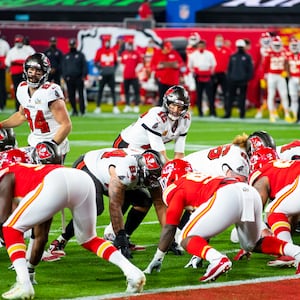Hockey is the only sport where bare-knuckle fighting is tolerated, at least in North America. This was on display just four days ago during the second game of the NHL’s Stanley Cup Finals, when the Tampa Lightning and Colorado Avalanche got into a team-wide brawl, just a few minutes before the Avalanche closed out a 7-0 shutout. Although this was more extreme than the NHL normally tolerates, fighting in hockey is a century-old tradition, and a draw to the game for at least some fans.
And NHL officials have tolerated as much by putting forth the argument that these skirmishes help deter more heightened levels of violence and dangerous plays during the game. League commissioner Gary Bettman said as much as recently as 2019 during a testimony in front of the Canadian parliament.
Turns out that reasoning might just be a bunch of bull. In his 2019 testimony, Bettman suggested there was no way to empirically prove out his argument that fighting deters worse violence in the game. But an Ohio State University social science researcher and former collegiate and professional hockey player, Michael Betz, decided to do what scientists do: study this himself. In a paper published in PLOS ONE Wednesday, found that fighting does nothing to mitigate hockey players from engaging in more violent behaviors during the game. In fact, those who fight disproportionately commit a greater number of violent and unsafe penalties.
Betz’s study isn’t all that complicated. He collected information on every game-time penalty doled out in the NHL from 2010 to 2019, distinguishing strategic penalties (like tripping, hooking, and holding), from violent ones that are specifically aimed at injuring or intimidating other players (like boarding, charging, elbowing, and roughing). Then he analyzed the data for relationships that would demonstrate whether fight incidents result in less violent play, using six different methodological approaches to answering the question.
“Not a single empirical approach yielded any evidence that fighting or even the threat of fighting deters violence in the NHL,” Betz wrote in his study. “To the contrary, the results suggest that fighting is strongly correlated with more violence—both at the team and individual game levels.”
Betz told The Daily Beast he wasn’t especially surprised by the findings. “Imposing physical size and aggression are two skills that are needed for fighting, so it’s not surprising that players who are more likely to fight try to leverage these assets in other ways, like more aggressive physical play.” He added that the NHL “shouldn’t continue to defend fighting as a means to deter greater violence.”
From his playing days, Betz remembered stories of teammates being careful so as not to spur on the opposing team’s “enforcer,” a term used to describe a team’s designated fighter, to start up a fight. But he also remembered many more experiences where a fight in the game “actually ratcheted up the level of dangerous plays.” The one thing he was surprised about, he said, “was how overwhelmingly consistent the results were.”
Banning fighting in the NHL could be especially important as we’re learning more about the effects of traumatic brain injuries on athletes. It would not only make the NHL safer, but could also create effects downstream by lessening aggressive and dangerous behavior in amateur and junior hockey leagues across North America, which are big training grounds for teenage players moving into the professional ranks and still tolerate fighting.
“Maybe fighting does deter some players from violent behavior, but it also ratchets up dangerous plays in the game,” said Betz. “At best, these effects offset each other. But at worst they can increase the level of dangerous plays and risk of head injury in the game. I think if the NHL is serious about reducing head injuries, then eliminating fighting is a bit of a no-brainer.”
To be fair, bare-knuckle fighting has already gone down precipitously over time. It’s almost non-existent in the Stanley Cup Playoffs (just nine fights in 85 games). As we head into Game 4 Wednesday night, the chances of seeing a fight break out are remote. But a league that continues to tolerate fighting is really just encouraging more violence—putting its players at greater risk of serious injury. “They shouldn’t continue to defend fighting as a means to deter greater violence,” said Betz.








